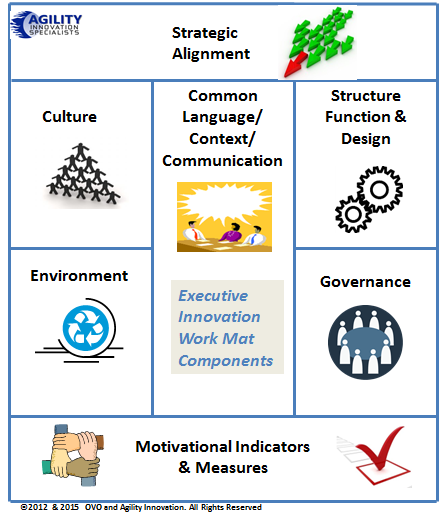 Recently I have been hearing a lot about different innovation equations that will deliver value on the efforts you put in.
Recently I have been hearing a lot about different innovation equations that will deliver value on the efforts you put in.
I think the activity behind all of this is actually very encouraging, it shows the current dissatisfaction with what we have and the quest for providing a formula for overcoming this ‘present state’.
I think they are all contributing to a promising future. Yet we need to consider the balance within any innovation understanding or equation to derive its real value.
At least this introduction allows me to work in a few of my own contributions here. If you are interested in them, then click on the link, if not just carry on, simple as that, it is your choice.
Some of my contributions towards innovation understanding
I offered up the innovation pathway curve of understanding that has five learning curves for determining your innovation and the migration path to a different future. This suggests we need to break innovation down into its manageable parts. Innovation does not just have a time axis that the three horizons framework refers too but it has a complexity and scope axis in learning as well.
Then I offered up the “building an innovation framework that has real capabilities at its heart” which argues that a ‘given’ formula of SCA = II + OC + EE + MLC + RNE, ‘suggests’ this formula as the combination of positive relationships between the following interrelated parts, so as to deliver a far superior innovation outcome. I have to admit I can’t let go of this one!
My third offering was a joint collaboration with Jeffrey Philips, over at Ovo. This is summarized in “Critical aspects of the Collaborative Innovation Framework”. This is also covered off in a dedicated site at http://cirf.pbworks.com.
Jeffrey and I picked up the baton again in a further collaboration on part of the innovation equation with an alignment view, we called this “the Executive Innovation Work Mat” and went into a significant open dialogue on this as we both judged it as critical and important to advance innovation.
I completed a whole series on this and its seven parts. This rumbles on and gathers recognition of its value to making innovation change. This was the piece of work dearest to my heart.
I think I have missed a few but it all depends on how you understand “equation”. Back in 2012 (oh it seems so long ago) I wrote a piece called “Two sides of an equation for shaping innovation” and this is where I want to focus upon within this post: “balancing our innovation understanding”
I really think we need to understand the two sides of the innovation balance sheet
When Jeffrey and I were working though the initial thinking behind the Executive Innovation Work Mat I saw these two sides really clearly.
Actually we captured it in the final framing, we clearly saw these two distinct sides to consider yet are so mutually dependent. My balance sheet thinking.

The left side of the innovation work mat or my balance sheet contains the soft side of innovation, far more the intangibles of culture, climate and environment, whereas the right side is more the hard aspects, the tangibles of process, design, governance, structure and function.
The middle is the place to build the common language of understanding, look for communicating, cascading and setting innovation in its rightful context to clarify how and why that ‘we’ set about the innovation activities in this particular way.
So is it two sides or made up of three? Well each of the sides, the intangibles more on the left and the tangibles, more determined on the right, make up the hard and soft factors and these all make up innovation that contributes into the middle, where the ‘innovation energy’ is confirmed.
The balance sheet construct delivers the equity equation you gain as the trade off or innovation catalyst, it needs presenting in different narratives and supportive actions . As you achieve a clarity of you ‘innovation energy’, based on your capabilities and capacities to innovate, you deliver the understanding and growing competencies, the required effort and contribution that can be achieved from the extraction from the two sides of the balance sheet.
That is why communicating, cascading, building a common language and the context is in the middle, central to extracting the best result from the two sides of this work mat.
At the time Jeffrey and I were looking at the informal mechanisms and formal mechanisms that contribute into these two sides of the innovation balance sheet.
Here is a list of the factors we felt were major contributors (far from exhaustive) to the soft side of our balance sheet that is made up of culture, climate and environment as our brainstorming to move us to the criteria that always lie under the top-level innovation balance sheet and then the ones that make up the harder side.
Some of course are inter-changeable or reliant on each other, but it gives a decent understanding of what makes up the balance sheet needs we all must have in place to have a thriving innovation organization.
Informal mechanisms (the contributors to the left side of our innovation balance sheet)
Those that are leading to improving the softer aspects of innovation or our left side of the innovation balance sheet) that would contribute to its build.
• Uncovering good and emerging practices in innovation
• The value of good leadership & distinct culture creating the linkages
• Targets and partner identification for relating and collaborating
• Skill of working together effectively – team building, encouraging diversity
• Integrating external parties to leverage through networks and relationships.
• Framing ambitions and plans of strategic targets and relating those to individuals
• Engaging the outer peripheries to capture insights and needs to drive engagement
• Exchanging expertise and seeking synergy in exchanges
• Story telling/ narratives- relating and explaining, sharing and extending
• More bottom-up engagement in formulation – sharing and informing
• Seeking individual insights, encouraging an open learning environment
• Developing the agility to quickly react to changes, effective and decisive intent
• Work on speed, external orientation and improvisation, flexible and adaptive
• To promote “doing more with the same”, less rework.
• The CEO acts as the central source of encouragement and determination
• Encourage informally at all levels in exchange
The formal mechanisms (the contributors to the right side of the innovation balance sheet)
Those that contribute to the make-up of the harder aspects of innovation or our right side of the innovation balance sheet that build this part.
• Ingraining innovation as a corporate function
• Determining how you lead and manage this, how you develop this out in its parts
• Identify the constraints, articulate the resolutions, recognise the boundaries
• Optimizing the process and structures, constantly reviewing to improve
• Determining the allocation of funds to offer the balance needed to achieve the goals
• Innovation portfolio management designed
• Type of openness to innovation flows to encourage and drive outcomes
• Embedding technology and capacity for rapid experimentation, and discovery
• Rapid ideas, discard failing ones & triple investment on good ideas
• Distance from Customer – determining the importance and setting about the connecting
• Ingrain as a corporate functionality the need to always be conscious of greater alignment
• Determining how you lead and manage through governance and design.
• Identify the constraints and boundaries, pushing and probing
• Optimizing the process and structures on an ongoing basis
• Determining the allocation of funds into the different framing activities
• Innovation portfolio management, striving for value, impact and return
• Type of openness to innovation flows and external engagements needed
• Embedding technology and capacity for rapid results and early wins
• Rapid ideas, discard failing ones & triple investment on good ideas, experiment and explore
• Involvement from both Customer and other stakeholders within your innovation process
These were not an exhaustive list, (well they are in many ways) they were the framing or triggering points to relate to the different aspects that need to be balanced when you consider innovation.
The essential seven parts of innovation understanding

The whole reason we believed in the work mat construct was the make-up of its seven parts. The left side contains the essential aspects of designing the culture, the climate, the environment and how these contribute into the innovation equation. These are far more intangible, softer but vital to make innovation work as they are more people orientated.
The right side consists of the function, design, process, structures and governance that make up the harder aspects, those that facilitate innovation. These are the enablers that manage innovation.
Each side outlined here contributes to the context, the communication and cascading of innovation throughout the organization.
While the Strategic Alignment links all the innovation activities into the corporate agenda. Its goals, strategies and contributes to the need for investments and achievement timescales.
At the bottom of our work mat we have as our ‘flow through point’ – the motivational indicators and measures to gain and frame the outcomes we want to achieve.
For all this you do need this cascading, this common language and context and this is why it sits in the middle, it is the glue that holds all the work mat parts together, to make it identifiable, to complete our view of the innovation equation we need in place.
Deciding the innovation equation is appreciating the value underpinning the balance sheet.
For me, the equation you decide to follow has to be robust; it has to account for a more holistic view of innovation.
We are moving towards better framing techniques for innovation to advance, it is certainly going to be always be made up of part art and part science, yet by us having a clear balance sheet of understanding to think through, in this work mat thinking, this will offer the underpinning that the innovation equation requires, that is ‘sound’ and ‘solid’ to invest into.
1 thought on “Balancing Our Innovation Understanding”
Comments are closed.